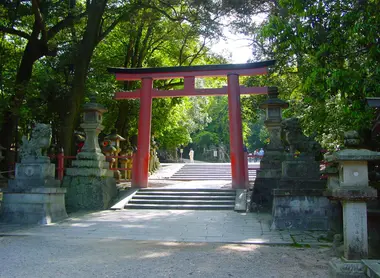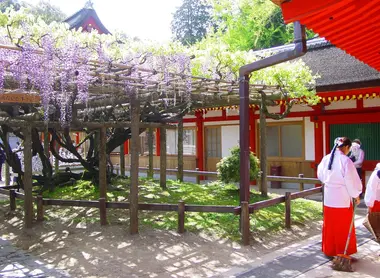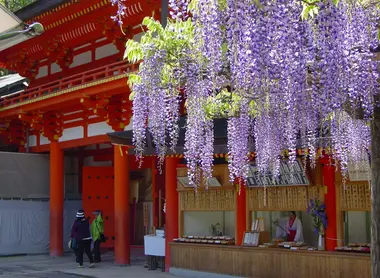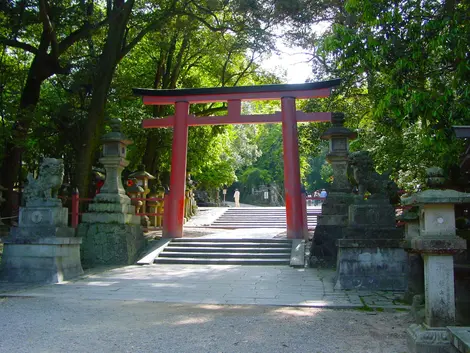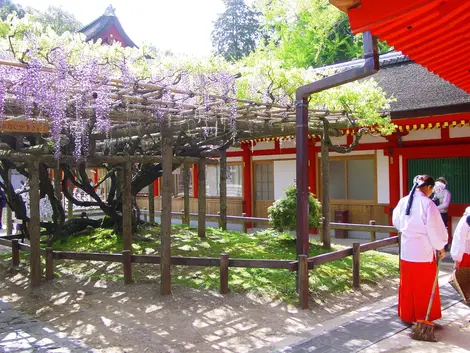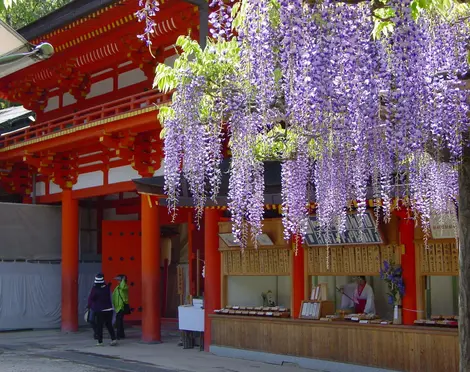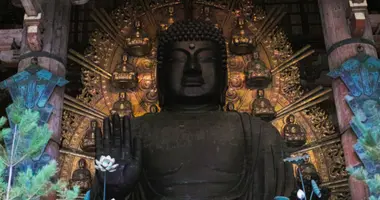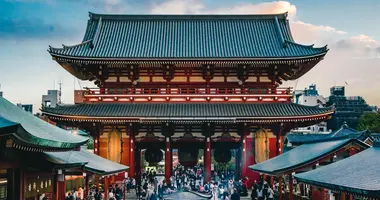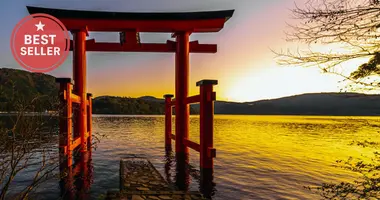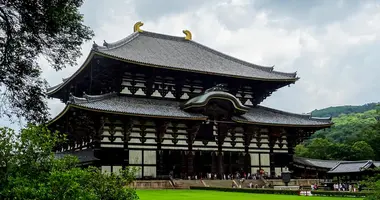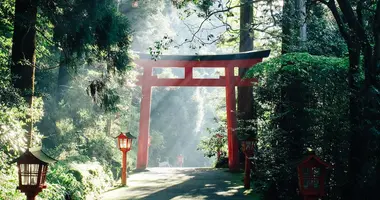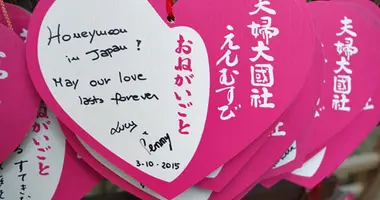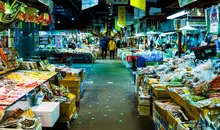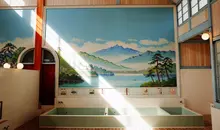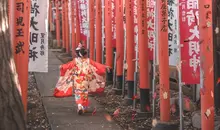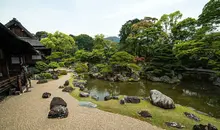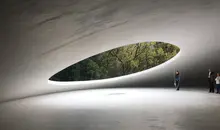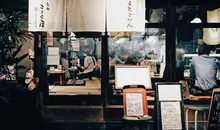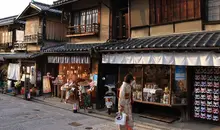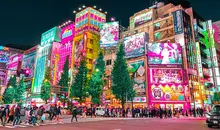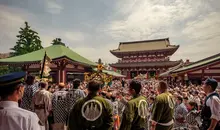Kasuga Taisha, Nara's lantern shrine
- Published on : 14/02/2024
- by : R.Z.
- Youtube
Set in the heart of a majestic sacred forest at the foot of Mount Mikasa, the Kasuga Taisha Shinto Shrine is one of Japan's oldest and most important. Founded in 768 by the powerful Fujiwara clan, this ancestral place of worship enchants visitors with its brilliant colors, thousands of lanterns and anecdotal encounters with deer messengers of the gods. Listed as a UNESCO World Heritage Site since 1998, Kasuga Taisha is a spiritual and architectural jewel that invites you on a journey back in time to the heart of the roots of Shintoism.
History and origins of Kasuga Taisha
Kasuga Taisha's origins date back to the 8th century, shortly after the imperial capital was established in Nara in 710. According to legend, the deity Takemikazuchi appeared on Mount Mikasa riding a white deer, advising the Fujiwara clan to build a shrine on these sacred grounds. Officially inaugurated on November 9, 768 by Fujiwara no Nagate, Minister of the Left, at the instigation of Empress Shōtoku, Kasuga Taisha became the tutelary shrine of the powerful Fujiwara family.
Over the centuries, the shrine enjoyed imperial support and great spiritual influence. In the Middle Ages, it was the scene of a flourishing syncretism between Shintoism and Buddhism, with its deities considered to be manifestations of Buddhas. This phenomenon, typical of the period, is known as honji suijaku. Kasuga Taisha was influenced by the Kōfuku-ji monastery, the Fujiwara's tutelary temple. Although this syncretism came to an end with the separation of the two religions in the Meiji era, Kasuga Taisha remained one of the 22 first-rate shrines supported by the government until 1946.
Shrine architecture and features
Kasuga Taisha's grounds are home to many flamboyantly-colored buildings, harmoniously blending vermilion pillars, white walls and cypress roofs. Japan's national treasure, the main pavilion (honden) built in the kasuga-zukuri style gives its name to this type of architecture characterized by a curved gable roof. The two-storey Rōmon gate, the long corridors with their 1,000 bronze lanterns donated by worshippers, the fence and other ancillary buildings are classified as important cultural assets.
But perhaps the most striking feature of Kasuga Taisha is the thousands of stone lanterns that line the path leading to the shrine for almost a kilometer. Some of them feature deer motifs, which visitors are delighted to unearth. Twice a year, in February and August, the shrine's 3,000 lanterns are all lit at dusk during the mantōrō ceremony, offering a mesmerizing spectacle with their flickering flames.
Deities worshipped at Kasuga Taisha
As the Fujiwara clan's tutelary shrine, Kasuga Taisha honors the family's protective and ancestral deities. The four main kami, each with their own pavilion, are, in order of importance: Takemikazuchi, god of thunder from the Kashima shrine; Futsunushi from the Katori shrine; Amenokoyane and his wife Himegami from the Hiraoka shrine. The first two are the Fujiwara's protectors, while Amenokoyane is considered their divine ancestor.
Thirteen subsidiary shrines within the compound house secondary deities associated with the Kasuga Taisha cult. The most important is Ame-no-oshikumone, worshipped at Wakamiya Shrine, son of Amenokoyane and Himegami. Next comes Enomoto, who according to legend inhabited the site before the arrival of the four main kami. In the Middle Ages, Kasuga's deities were seen as manifestations of certain Buddhas, in a syncretism typical of the period known as honji suijaku.
Kasugayama forest and surrounding area
Kasuga Taisha Shrine stands at the foot of Mount Kasuga, in the heart of the 250-hectare Kasugayama primeval forest. Protected since 841, when the mountain was declared sacred, this ancient forest is home to remarkable biodiversity, with 175 species of tree, 60 species of bird and 1,180 species of insect. Rare varieties such as the 600-year-old sacred cedar and the flying frog populate this World Heritage-listed natural sanctuary.
In the immediate vicinity of the sanctuary lies the Man'yo botanical garden, with over 200 varieties of plants, including the sumptuous wisteria, which explodes purple in late April. The path leading to Kasuga Taisha, lined with lanterns and century-old trees, crosses Nara Park, where visitors have amusing encounters with sacred deer, messengers of Takemikazuchi according to legend. These tame deer, protected since 1957, roam in peace, much to the delight of walkers.
Celebrations and events
A mecca of Japanese spirituality, Kasuga Taisha is the scene of numerous ceremonies and celebrations throughout the year. The most spectacular are undoubtedly the Setsubun Mantoro illuminations in early February and the Obon Mantoro in mid-August, when the shrine's 3,000 lanterns blaze into the night. In early December, the Kasuga Wakamiya On-matsuri showcases traditional performing arts in a historic procession.
Another highlight is the Shikinen Zotai ritual reconstruction ceremony. Every twenty years, the buildings and structures of Kasuga Taisha are dismantled and then rebuilt identically in order to perpetuate artisan techniques and rejoice the deities. The latest reconstruction dates from 2016 and was the 60th since the shrine was founded over 1,200 years ago! Every day, morning and evening, Shinto priests hold services before the deities, praying for the protection of Japan and world peace.
Visit the Kasuga Taisha
The Kasuga Taisha shrine lies to the east of Nara Park, about 2 km from Nara kintetsu station. It's a 30-minute walk into the park, or a short bus ride to the Kasuga Taisha Honden stop. The approach path lined with stone lanterns is an experience in itself, preparing you for the discovery of the sanctuary. The main entrance is through the imposing Nanen Gate, followed by the majestic Rōmon Gate.
To take full advantage of the beauty and serenity of the site, it's best to visit outside peak periods. Allow at least an hour on site to admire the buildings, the lanterns and take a soothing stroll through the sacred undergrowth. Don' t forget that this is a place of worship: a calm and respectful attitude is required. If you wish, you can buy a goshuin, a red stamp to commemorate your visit to this exceptional sanctuary.
A place of meditation for centuries, the Kasuga Taisha Shrine invites you on a timeless spiritual journey. From the solemnity of its vermilion buildings to the mysterious stone lanterns and the beauty of its natural surroundings, this jewel of Nara amazes as much as it soothes. A must-see to soak up the essence of Shintoism and the Japanese soul.
Practical info: Address: 160 Kasuganocho, Nara, 630-8212 Telephone: +81 (0)74 227 2114. Times: Open daily from 6.30 a.m. to 5 p.m. (6.30 p.m. from April to September) Admission: 500 yen for the main shrine, 500 yen for the botanical garden (250 yen for children) Access: Nara Kotsu bus to "Kasuga Taisha Honden" stop from Kintetsu Nara station (15-20 minutes) or JR Nara (25-30 minutes)
Address, timetable & access
Address
Phone
+81 (0)74 227 2114.Timetable
kasuga Taisha Honden stop on JR West or Kintetsu Railways bus routes from their respective stations. Approx. 25-minute walk from Kintetsu Railways station.Price
entrance fee to botanical gardens: 500 yen for adults and 250 yen for children.Access
open daily from 6 a.m. to 5 p.m. in winter and 6 p.m. in summer.
